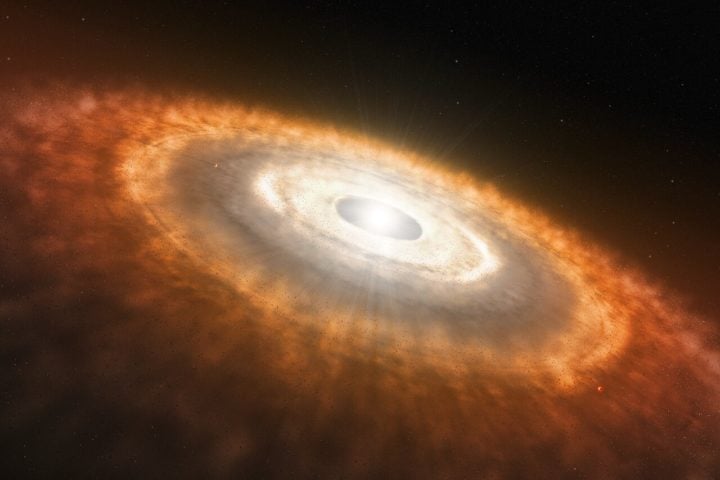Planets like our Earth could form even in the harshest known star-forming environments, drenched by hard UV light from massive stars. That is the main result of analyses of new observations of such an environment with the James Webb Space Telescope.
The observations are the first of their kind – before James Webb, this kind of detailed observation was impossible. This is good news for Earth-like planets and for life in the universe: there is a great variety of environments in which such planets can form.

This is an artist’s impression of a young star surrounded by a protoplanetary disc in which planets are forming. Image credit: ESO/L. Calçada
Water and carbon-bearing molecules have been discovered in a disk of gas and dust surrounding a young solar-type star, which is located in one of the most extreme environments in our Galaxy. Such disks are where planets form around nascent stars.
A team of astronomers led by María C. Ramírez-Tannus at the Max Planck Institute for Astronomy made use of the James Webb Space Telescope to peer into the inner region of the disk, which is where planets similar to our Earth are expected to form: so-called terrestrial planets, with a thin atmosphere covering a planet made of rock.
The disk, which the astronomers call XUE-1, is exposed to intense ultraviolet radiation of nearby hot, massive stars. Yet even in this harsh environment, the observations detected both water and simple organic molecules. Ramírez-Tannus says: “This result is unexpected and exciting! It shows favourable conditions to form Earth-like planets and the ingredients for life even in the harshest environments in our Galaxy.”
Where massive stars are formed
The new observations are the first of their kind. Until now, nothing was known about the effects of such inhospitable environments on the inner regions of discs, where terrestrial planets are likely to form. Previous detailed observations of planet-forming disks had been limited to nearby star-formation regions, where these disks are easier to observe but where massive stars do not exist.
Massive star-forming regions are completely different: there, numerous stars form at roughly the same time, including some of the rare, but extremely powerful very massive stars.
Around 10 billion years ago, most star formation took place in such massive clusters during the’ golden age’ of the universe. Overall, more than half of all stars in our universe – including our own Sun – were born in massive star-forming regions, together with their planets. Massive star-forming regions are rare in the present-day universe, and even the nearest ones are far away.
Massive stars are perforce very bright, giving off large amounts of high-energy UV radiation. Their presence causes considerable disruption in their vicinity. It was an open question whether that disruption would routinely interfere with the formation of planets like Earth around stars similar the Sun – which would relegate Earth-like planets to the sidelines in such massive clusters, not impossible to form, but very rare.
There were plausible arguments that this could be the case. For instance, UV radiation from the massive stars disperses the gas in the outer disk portions, which inhibits the growth and the inward drift of dust particles that are the building blocks of Earth-like planets (and also of the cores of giant planet like Jupiter or Saturn). This might well stack the odds against the formation of Earth-like planets.
Planet-forming discs under strong UV radiation
This changed with the advent of the James Webb Space Telescope. When the telescope became available for science observations, Ramírez-Tannus and the XUE (eXtreme UV environments) collaboration, successfully applied to observe NGC 6357.
At a distance of 5500 light-years from Earth, this is one of the nearest massive star-forming regions. It is also the most promising observational target to answer how strong UV radiation affects the inner regions of a planet-forming disc: because NGC 6357 contains about a dozen luminous, massive stars, in addition to some planet-forming discs observable with James Webb.
“If intense radiation hampers the conditions for planet formation in the inner regions of protoplanetary disks, NGC 6357 is where we should see the effect.”, says Arjan Bik from Stockholm University.
The observations the astronomers performed record spectra: rainbow-like decompositions of light that allow estimates of the presence of specific molecules in the observed region.
To their surprise, Ramírez-Tannus and her colleagues found that, when it comes to the presence (and properties) of key molecules, at least one of the inner disks in NGC 6357, namely XUE-1, is not fundamentally different from its counterparts in low-mass star-formation regions.
Water and other more complex molecules in a harsh environment
“We found an abundance of water, carbon monoxide, carbon dioxide, hydrogen cyanide and acetylene in the innermost regions of XUE-1” says Ramírez-Tannus.
“This provides valuable clues about the likely composition of the initial atmosphere of the resulting terrestrial planets.” The researchers also found silicate dust in similar amounts as in low-mass star-formation regions. This is the first time that such molecules have been detected under extreme conditions like these.
The observations are good news for Earth-like planets, and for life in the universe: Apparently, the inner regions of protoplanetary disks around sun-like stars located in some of the harshest star-forming environments are just as capable of forming Earth-like, rocky planets as their low-mass counterparts.
They even provide for an abundance of water, a necessary ingredient for life as we know it. Whether or not this translates to a significantly large number of Earth-like planets born in such environments is not something the researchers can tell from looking at a single disk.
The XUE collaboration is taking their observations further: with a JWST survey of 14 additional disks in different parts of NGC 6357 that should go a long way towards settling that important question.
Source: MPG

